CS 30
The CS 30 is a Canadian sailboat, that was designed by Tony Castro and first built in 1984. The design is out of production.[1][2][3]
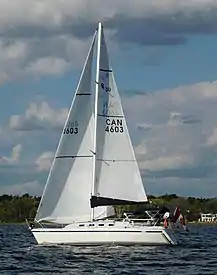 | |
| Development | |
|---|---|
| Designer | Tony Castro |
| Location | Canada |
| Year | 1984 |
| No. built | 500 |
| Builder(s) | CS Yachts |
| Boat | |
| Boat weight | 8,000 lb (3,629 kg) |
| Hull | |
| Type | Monohull |
| Construction | Fiberglass |
| LOA | 30.00 ft (9.14 m) |
| LWL | 25.42 ft (7.75 m) |
| Beam | 10.25 ft (3.12 m) |
| Hull draft | 5.50 ft (1.68 m) |
| Engine type | Volvo diesel engine 18 hp (13 kW) |
| Hull appendages | |
| Keel/board type | fin keel |
| Ballast | 3,440 lb (1,560 kg) |
| Rudder(s) | internally-mounted spade-type rudder |
| Rig | |
| General | Masthead sloop |
| I (foretriangle height) | 42.00 ft (12.80 m) |
| J (foretriangle base) | 12.00 ft (3.66 m) |
| P (mainsail luff) | 36.50 ft (11.13 m) |
| E (mainsail foot) | 11.50 ft (3.51 m) |
| Sails | |
| Mainsail area | 209.88 sq ft (19.498 m2) |
| Jib/genoa area | 252.00 sq ft (23.412 m2) |
| Total sail area | 461.88 sq ft (42.910 m2) |
| Racing | |
| PHRF | 156 (average) |
Production
The boat was built by Canadian Sailcraft in Canada. It became their most successful model, with 90 built the first year and 500 completed over the whole production run from 1984-1990.[1]
Design
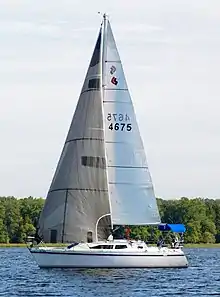
The CS 30 is a small recreational keelboat, built predominantly of fiberglass, with wood trim. It has a masthead sloop rig, an internally-mounted spade-type rudder, reverse transom and a fixed fin keel. It displaces 8,000 lb (3,629 kg) and carries 3,440 lb (1,560 kg) of ballast.[1][2]
The boat has a draft of 5.50 ft (1.68 m) with the standard keel, 4.25 ft (1.30 m) with the optional shoal draft keel and 4.5 ft (1.4 m) with the optional wing keel.[1][4][5]
The boat is fitted with a Volvo diesel engine of 18 hp (13 kW). The fuel tank holds 19 U.S. gallons (72 L; 16 imp gal) and the fresh water tank has a capacity of 30 U.S. gallons (110 L; 25 imp gal).[1]
The winged keel version of the boat has a PHRF racing average handicap of 156 with a high of 185 and low of 144. It has a hull speed of 6.76 kn (12.52 km/h).[2]
Operational history
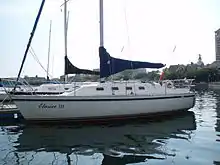
In a review Michael McGoldrick wrote, "The CS 30 was introduced in the mid 1980s, and it was an immediate hit with sailors who had outgrown their 26 and 27 footers. It is a newer design which features a fairly long waterline, a wide transom, and double spreaders. And while it doesn't quite have an enclosed aft cabin, it comes very close with a large aft double berth ... Approximately five hundred CS 30s were built during the latter half of the 1980s. Unlike the large windows illustrated on line drawings, many of these appear to have been built with 8 smaller opening ports (similar to what is found on the CS 36 Traditional)."[6]
See also
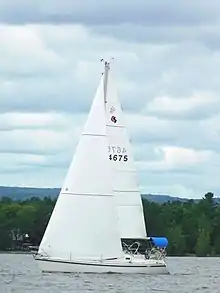
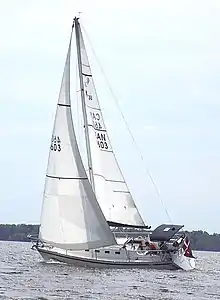
Similar sailboats
- Alberg 30
- Alberg Odyssey 30
- Aloha 30
- Annie 30
- Bahama 30
- Bristol 29.9
- Cal 9.2
- C&C 1/2 Ton
- C&C 30
- C&C 30 Redwing
- Catalina 30
- Catalina 309
- Grampian 30
- Hunter 29.5
- Hunter 30
- Hunter 30T
- Hunter 30-2
- Hunter 306
- J/30
- Kirby 30
- Leigh 30
- Mirage 30
- Mirage 30 SX
- Nonsuch 30
- O'Day 30
- Pearson 303
- S2 9.2
- Santana 30/30
- Seafarer 30
- Southern Cross 28
- Tanzer 31
References
- Browning, Randy (2017). "CS 30 sailboat specifications and details". sailboatdata.com. Retrieved 31 January 2017.
- InterVisionSoft LLC (2017). "Sailboat Specifications for CS 30". Sailing Joy. Retrieved 31 January 2017.
- Browning, Randy (2017). "Tony Castro". sailboatdata.com. Retrieved 31 January 2017.
- InterVisionSoft LLC (2017). "Sailboat Specifications for CS 30 SD". Sailing Joy. Retrieved 31 January 2017.
- InterVisionSoft LLC (2017). "Sailboat Specifications for CS 30 WK". Sailing Joy. Retrieved 31 January 2017.
- McGoldrick, Michael (2018). "CS 30". Sail Quest. Retrieved 24 July 2018.
External links
![]() Media related to CS 30 at Wikimedia Commons
Media related to CS 30 at Wikimedia Commons
